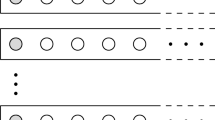Abstract
Classical mereology (CM) is usually taken to be formulated in a tenseless language, and is therefore associated with a four-dimensionalist metaphysics. This paper presents three ways one might integrate the core idea of flat plenitude, i.e., that every suitable condition or property has exactly one mereological fusion, with a tensed logical setting. All require a revised notion of mereological fusion. The candidates differ over how they conceive parthood to interact with existence in time, which connects to the distinction between endurance and perdurance. Similar issues arise for the integration of mereology with modality, and much of our discussion applies to this project as well.
Similar content being viewed by others
References
Barnes, E., & Williams, R. (2011). A theory of metaphysical indeterminacy. In K. Bennett, & D. W. Zimmerman (Eds.), Oxford studies in metaphysics (Vol. 6). Oxford University Press.
Burgess, J. (2002). Basic tense logic. In D. Gabbay, & F. Guenthner (Eds.), Handbook of philosophical logic, 7 (Vol. 165, pp. 1–42). Kluwer.
Burke, M. B. (1994). Dion and theon: An essentialist solution to an ancient puzzle. Journal of Philosophy, 91(3), 129–139.
Burke, M. B. (1994). Preserving the principle of one object to a place: A novel account of the relations among objects, sorts, sortals, and persistence conditions. Philosophy and Phenomenological Research, 54(3), 591–624.
Carnap, R. (1947). Meaning and necessity: A study in semantics and modal logic. Chicago: University of Chicago Press.
Chisholm, R. (1973). Parts as essential to their wholes. Review of Metaphysics, 26(4), 581–603.
Chisholm, R. (1976). Person and object: A metaphysical study. Open Court.
Crisp, T. M., & Smith, D. P. (2005). ‘Wholly present’ defined. Philosophy and Phenomenological Research, 71(2), 318–344.
Fine, K. (1994). Compounds and aggregates. Noûs, 28(2), 137–158.
Fine, K. (2003). The problem of possibilia. In M. J. Loux, & D. W. Zimmerman (Eds.), The Oxford handbook of metaphysics (pp. 161–179). Oxford University Press.
Fine, K. (2005). Tense and reality. In Modality and tense. Oxford University Press.
Hawthorne, J. (2006). Three-dimensionalism. In Metaphysical essays. Oxford University Press.
Hovda, P. (2009). What is classical mereology? Journal of Philosophical Logic, 38(1), 55–82.
Hughes, G. E., & Cresswell, M. J. (1996). A new introduction to modal logic. Routledge.
Johnston, M. (1987). Is there a problem about persistence? Aristotelian Society, Supplementary Volume, 61, 107–35.
Lewis, D. (1983). Philosophical papers (Vol. 1). Oxford University Press.
Lewis, D. (1986). On the plurality of worlds. Oxford: Basil Blackwell.
Lewis, D. (1991). Parts of classes. Blackwell.
Lewis, D. (2002). Tensing the copula. Mind, 111(441), 1–14.
McGee, V. (1997). How we learn mathematical language. Philosophical Review, 106(1), 35–68.
Mellor, D. H. (1998). Real time II. Routledge.
Pontow, C., & Schubert, R. (2006). A mathematical analysis of theories of parthood. Data and Knowledge Engineering, 59, 107–138.
Quine, W. V. O. (1960). Word and object. Cambridge: MIT Press.
Rea, M. C. (2000) Constitution and kind membership. Philosophical Studies, 97(2), 169–193.
Sider, T. (2001). Four-dimensionalism. Oxford.
Tarski, A. (1983). Foundations of the geometry of solids. In J. Corcoran (Ed.), Logic, semantics, meta-mathematics. Hackett.
Thomson, J. J. (1998). The statue and the clay. Noûs, 32(2), 149–173.
van Inwagen, P. (1990). Material beings. Cornell University Press.
van Inwagen, P. (2006). Can mereological sums change their parts? The Journal of Philosophy, 103(12), 614–630.
Wasserman, R. (2002). The standard objection to the standard account. Philosophical Studies, 111(3), 197–216.
Wasserman, R. (2006). The problem of change. Philosophy Compass, 1(1):48–57.
Yi, B.-Uk. (2005). The logic and meaning of plurals I. Journal of Philosophical Logic, 34(5–6), 459–506.
Yi, B.-Uk. (2006). The logic and meaning of plurals II. Journal of Philosophical Logic, 35(3), 239–288.
Author information
Authors and Affiliations
Corresponding author
Rights and permissions
About this article
Cite this article
Hovda, P. Tensed Mereology. J Philos Logic 42, 241–283 (2013). https://doi.org/10.1007/s10992-011-9220-4
Received:
Accepted:
Published:
Issue Date:
DOI: https://doi.org/10.1007/s10992-011-9220-4



